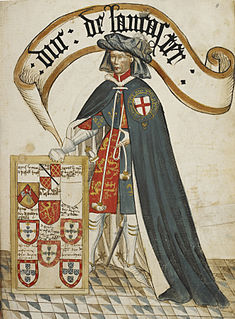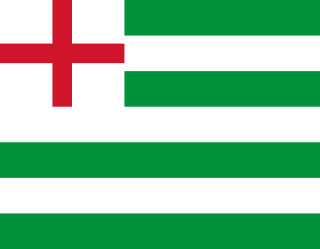
Edward III, also known as Edward of Windsor before his accession, was King of England and Lord of Ireland from January 1327 until his death in 1377. He is noted for his military success and for restoring royal authority after the disastrous and unorthodox reign of his father, Edward II. Edward III transformed the Kingdom of England into one of the most formidable military powers in Europe. His fifty-year reign was one of the longest in English history, and saw vital developments in legislation and government, in particular the evolution of the English Parliament, as well as the ravages of the Black Death. He outlived his eldest son, Edward the Black Prince, and the throne passed to his grandson, Richard II.

John of Gaunt, Duke of Lancaster was an English royal prince, military leader, and statesman. He was the third son of King Edward III of England, and the father of King Henry IV. Due to Gaunt's royal origin, advantageous marriages, and some generous land grants, he was one of the richest men of his era, and was an influential figure during the reigns of both his father and his nephew, Richard II. As Duke of Lancaster, he is the founder of the royal House of Lancaster, whose members would ascend the throne after his death. His birthplace, Ghent, corrupted into English as Gaunt, was the origin for his name. When he became unpopular later in life, a scurrilous rumour circulated, along with lampoons, claiming that he was actually the son of a Ghent butcher. This rumour, which infuriated him, may have been inspired by the fact that Edward III had not been present at his birth.

Yeoman is a noun originally referring either to one who owns and cultivates land or to the middle ranks of servants in an English royal or noble household. The term was first documented in mid-14th-century England. The 14th century also witnessed the rise of the yeoman longbow archer during the Hundred Years' War, and the yeoman outlaws celebrated in the Robin Hood ballads. Yeomen also joined the English Navy during the Hundred Years' War as seamen and archers.

The House of Lancaster was a cadet branch of the royal House of Plantagenet. The first house was created when King Henry III of England created the Earldom of Lancaster—from which the house was named—for his second son Edmund Crouchback in 1267. Edmund had already been created Earl of Leicester in 1265 and was granted the lands and privileges of Simon de Montfort, 6th Earl of Leicester, after de Montfort's death and attainder at the end of the Second Barons' War. When Edmund's son Thomas, 2nd Earl of Lancaster, inherited his father-in-law's estates and title of Earl of Lincoln he became at a stroke the most powerful nobleman in England, with lands throughout the kingdom and the ability to raise vast private armies to wield power at national and local levels. This brought him—and Henry, his younger brother—into conflict with their cousin King Edward II, leading to Thomas's execution. Henry inherited Thomas's titles and he and his son, who was also called Henry, gave loyal service to Edward's son King Edward III.

The Battle of Sluys, also called the Battle of l'Écluse, was a naval battle fought on 24 June 1340 between England and France. It took place in the roadstead of the port of Sluys, on a since silted-up inlet between Zeeland and West Flanders. The English fleet of 120–150 ships was led by Edward III of England and the 230-strong French fleet by the Breton knight Hugues Quiéret, Admiral of France, and Nicolas Béhuchet, Constable of France. The battle was one of the opening engagements of the Hundred Years' War.

Henry of Grosmont, 1st Duke of Lancaster was an English statesman, diplomat, soldier, and Christian writer. The owner of Bolingbroke Castle in Lincolnshire, Grosmont was a member of the House of Plantagenet, which was ruling over England at that time. He was the wealthiest and most powerful peer of the realm.

The Royal Scots Navy was the navy of the Kingdom of Scotland from its origins in the Middle Ages until its merger with the Kingdom of England's Royal Navy per the Acts of Union 1707. There are mentions in Medieval records of fleets commanded by Scottish kings in the twelfth and thirteenth centuries. King Robert I, developed naval power to counter the English in the Wars of Independence (1296–1328), and after the establishment of Scottish independence continued to build up naval capacity. In the late fourteenth century naval warfare with England was conducted largely by hired Scots, Flemish and French merchantmen and privateers. King James I, took a greater interest in naval power establishing a shipbuilding yard at Leith and probably created the office of Lord High Admiral.

The first phase of the Hundred Years' War between France and England lasted from 1337 to 1360. It is sometimes referred to as the Edwardian War because it was initiated by King Edward III of England, who claimed the French throne in defiance of King Philip VI of France. The dynastic conflict was caused by disputes over the French feudal sovereignty over Aquitaine and the English claims over the French royal title. The Kingdom of England and its allies dominated this phase of the war.

The Battle of Winchelsea or the Battle of Les Espagnols sur Mer was a naval battle that took place on 29 August 1350 and was a victory for an English fleet of 50 ships, commanded by King Edward III, over a Castilian fleet of 47 larger vessels, commanded by Charles de La Cerda. Between 14 and 26 Castilian ships were captured, and several were sunk. Only two English vessels were sunk, but there was a significant loss of life. The battle was part of the Hundred Years' War between England and France.

John Hastings, 2nd Earl of Pembroke,, was a fourteenth-century English nobleman and soldier. He also held the titles Baron Abergavenny and Lord of Wexford. He was born in Sutton Valence, the son of Laurence Hastings, 1st Earl of Pembroke, and Agnes Mortimer. His father died when John Hastings was a year old, and he became a ward of King Edward III while remaining in his mother's care. The King arranged for John to marry Edward's daughter Margaret in 1359, which drew John into the royal family. However, Margaret died two years later. John Hastings inherited his father's earldom, subsidiary titles and estates in 1368. The same year he made a second marriage, to Anne, daughter of Walter, Lord Mauny. The following year Pembroke began the career in royal service that was to continue for the rest of his life.

The Tudor navy was the navy of the Kingdom of England under the ruling Tudor dynasty (1485–1603). The period involved important and critical changes that led to the establishment of a permanent navy and laid the foundations for the future Royal Navy.

The Battle of Caen was an assault conducted on 26 July 1346 by forces from the Kingdom of England, led by King Edward III, on the French-held town of Caen and Normandy as a part of the Hundred Years' War.

Henry de Percy, 1st Baron Percy of Alnwick was a medieval English magnate.

The Hundred Years' War was a series of armed conflicts between the kingdoms of England and France during the Late Middle Ages. It originated from disputed claims to the French throne between the English royal House of Plantagenet and the French royal House of Valois. Over time, the war grew into a broader power struggle involving factions from across Western Europe, fuelled by emerging nationalism on both sides.
The English invasion of Scotland of August 1400 was the first military campaign undertaken by Henry IV of England after deposing the previous king, his cousin Richard II. Henry IV urgently wanted to defend the Anglo-Scottish border, and to overcome his predecessor's legacy of failed military campaigns.

The Clerk of the Acts, originally known as the Keeper of the King's Ports and Galleys, was a civilian officer in the Royal Navy and a principal member of the Navy Board. The office was created by King Charles II in 1660 and succeeded the earlier position of Clerk of the Navy(1546 to 1660). The Clerk was responsible for the organisation of Navy Office, processing naval contracts and coordinating the administrative and secretarial side of the Navy Board's work. The post lasted until 1796, when its duties were merged with that of the Second Secretary to the Admiralty later known as the Permanent Secretary to the Admiralty.

The Admiral of the North also known as Admiral of the Northern Seas and Admiral of the Northern Fleet was a senior English Navy appointment. The Admiral was chiefly responsible for the command of the navy's fleet that operated in the North Sea and off the English coast out of Yarmouth from 1294 to 1412.

The official history of the Royal Navy began with the establishment of the Navy Royal by Henry VIII in 1546. The modern incarnation of the institution re-emerged as the national naval force of the Kingdom of England in 1660, following the Restoration of King Charles II to the throne. However, for more than a thousand years before that there had been English naval forces varying in type and organization. In 1707 it became the naval force of the Kingdom of Great Britain after the Union between England and Scotland which merged the English navy with the much smaller Royal Scots Navy, although the two had begun operating together from the time of the Union of the Crowns in 1603.

The monarchy of the United Kingdom traces its origins from the petty kingdoms of Anglo-Saxon England and early medieval Scotland, which consolidated into the kingdoms of England and Scotland by the 10th century. Anglo-Saxon England had an elective monarchy, but this was replaced by primogeniture after England was conquered by the Normans in 1066. Wales gradually came under the control of Anglo-Normans, a process that was completed in the 13th century when the Principality of Wales became a client state of the English kingdom. Meanwhile, Magna Carta began the process of reducing the English monarch's political powers.
















